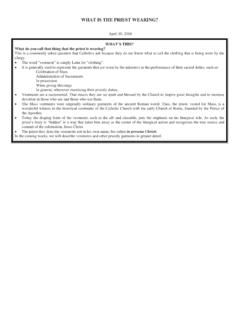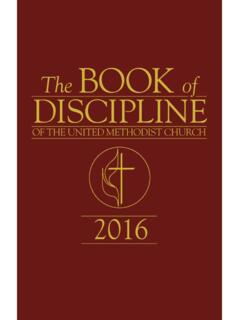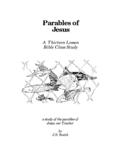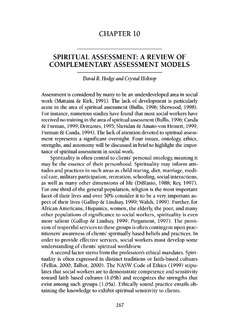Transcription of The Mass-Liturgy of the Eucharist - St John V
1 THE MASS LITURGY OF THE Eucharist May 3, 2015 WHAT S THIS? The Mass consists of four main sections. They are: Introductory Rites; Liturgy of the Word; Liturgy of the Eucharist and; Concluding Rites Liturgy of the Eucharist This part of the Mass corresponds to the words and actions of Jesus at the Last Supper. Christ took bread and the cup, gave thanks, broke, and gave them to His disciples saying, Take and eat, this is My Body. Take and drink, this is the cup of My Blood. Do this in memory of Me. WHAT S THIS? Liturgy of the Eucharist The Liturgy of the Eucharist , as the second main part of the Mass is called, is the major part of the Mass after the Liturgy of the Word and ending before the Concluding Rite. The priest, representing Christ the Lord, carries out what the Lord himself did at the Last Supper and handed over to his disciples to be done in his memory.
2 Christ took the bread and the chalice, gave thanks, broke and gave it to his disciples, saying: Take, eat and drink: this is my Body; this is the chalice of my Blood. Do this in memory of me. Hence, the church has arranged the entire celebration of the Liturgy of the Eucharist in parts corresponding to precisely these words and actions of Christ, namely: At the Presentation of the Gifts, bread and wine with water are brought to the altar, the same elements, that is to say, which Christ took into his hands In the Eucharistic Prayer, thanks is given to God for the whole work of salvation, and the offerings become the Body & Blood of Christ Through the breaking of the Bread and through Communion, we receive from the Lord s Body and the Lord s Blood in the same way that the Apostles received them from the hands of Christ himself.
3 The Liturgy of the Eucharist consists of three sections: the Preparation of the Gifts, the Eucharistic Prayer, and Communion. We might describe these as setting the table for the meal, saying the blessing, and sharing the meal together. The Liturgy of the Eucharist includes: Presentation of the Gifts and Preparation of the Altar Prayer over the Offerings Eucharistic Prayer The Lord s Prayer Sign of Peace Lamb of God Communion Prayer after Communion November 8, 2015 November 15, 2015 WHAT S THIS? Liturgy of the Eucharist The Liturgy of the Eucharist includes: Presentation of the Gifts and Preparation of the Altar Prayer over the Offerings Eucharistic Prayer The Lord s Prayer Sign of Peace Lamb of God Communion Prayer after Communion Presentation of the Gifts and Preparation of the Altar The Liturgy of the Eucharist begins with the preparation of the gifts and the altar.
4 The Preparation of the Gifts has rich symbolic meaning. Here the bread and wine and our monetary donations serve as symbols of our gifts and of ourselves. The collection gathered for the needs of the church and the poor speaks of our willingness to follow the Lord in caring for those in need. It also reminds us that all that we have, not just the portion that we put in the basket, belongs to God. The donations we make symbolize all that we have and ultimately all that we are. Our giving symbolizes our commitment to give our whole lives to God and to use all the gifts God has given us according to God s will. As the servers prepare the altar, representatives of the assembly bring forward the bread and wine that will become the Body and Blood of Christ.
5 The presentation of the bread and wine (the gifts) from the assembly reminds us that we are all involved in this act of worship, presider and assembly together. The celebrant blesses and praises God for these gifts and places them on the altar. Just as the gifts and the altar are prepared, so we prepare ourselves to enter into the great blessing prayer and the meal that is to follow. Excerpts taken from How We Worship The Eucharist , The Sacraments, and The Hours By Reverend Lawrence E. Mick THE MASS LITURGY OF THE Eucharist WHAT S THIS? Liturgy of the Eucharist The Liturgy of the Eucharist includes: Presentation of the Gifts and Preparation of the Altar Prayer over the Offerings Eucharistic Prayer The Lord s Prayer Sign of Peace Lamb of God Communion Prayer after Communion Prayer over the Offerings After the gifts and altar are prepared, the Prayer over the Offerings begins.
6 This Prayer of Thanksgiving is the heart of the Liturgy of the Eucharist . If you watch very closely, you ll notice that the priest is moving his lips and praying some prayers very quietly during the Preparation of the Gifts. In this prayer: The celebrant acts in the person of Christ as head of his body, the church He gathers not only the bread and the wine, but the substance of our lives and joins them to Christ s perfect sacrifice, offering them to the Father The silent prayers the priest says are: Blessed are you Lord God of all creation, for through your goodness, we have received the bread we offer you: fruit of the earth and work of human hands, it will become for us the bread of life. As the priest pours wine and a little water into the chalice, he prays quietly: By the mystery of this water and wine may we come to share in the divinity of Christ, who humbled himself to share in our humanity.
7 Blessed are you Lord God of all creation, for through your goodness, we have received the wine we offer you: fruit of the vine and work of human hands, it will become for us our spiritual drink. Then the priest bows profoundly and says quietly: With humble spirit and contrite heart may we be accepted by you, Oh Lord, and may our sacrifice in your sight this day be pleasing to you, Lord God. The Rite of Hand Washing is a symbolic gesture of purification. The priest prays Wash me, Oh Lord, from my iniquity, and cleanse me from my sin. Pray, brethren breaks the stillness and silence after the Lavabo, as an invitation to pray and claim ownership of the sacrifice. The priest invites us to pray that our offering may be worthy and acceptable before the Lord.
8 THE MASS LITURGY OF THE Eucharist November 22, 2015 WHAT S THIS? Although this is the first week of Advent, we will be continuing our explanation of the Mass. Please refer to the SJV website at for the What s This articles for Advent. They will be listed under Worship & Pray. Liturgy of the Eucharist The Liturgy of the Eucharist includes: Presentation of the Gifts and Preparation of the Altar Prayer over the Offerings Eucharistic Prayer The Lord s Prayer Sign of Peace Lamb of God Communion Prayer after Communion Eucharistic Prayer The Eucharistic Prayer is the central prayer of the liturgy. The word Eucharist comes from the Greek for thanksgiving, and this prayer is primarily an act of praise and thanks to God for all that God has done for us through the ages.
9 The prayer asks God to continue to bless us in our own time and concludes with words of praise (a doxology). Many people find it difficult to sustain their attention through the length of this prayer. Probably the most important thing is for all of us to remember that we are offering this prayer together with the presider. The opening dialogue and the three acclamations that the assembly sings as part of the prayer (Holy, Holy, Holy, Memorial Acclamation, and Great Amen) are reminders that this is a communal effort to give God proper praise and thanks. In the Catholic tradition, we believe that this prayer is also consecratory. The prayer is said over the bread and wine that have been set aside for the sacred meal, and through this prayer, the bread and wine become the Body and Blood of Christ.
10 The word transubstantiation has traditionally been used to express this change; it simply says that the substance or fundamental reality of the bread and wine change even though what we see and touch and taste, remain the same. What is more basic than the term, however, is the truth that the bread and wine are now the Body and Blood of the Lord, which means they are now a bodily means of his presence among us. He is present in the Eucharist just as fully as he was present in his human body during his thirty-plus years on earth. He is present for a purpose. He is present in the Eucharist in order to be our spiritual food and drink. Excerpts taken from How We Worship The Eucharist , The Sacraments, and The Hours By Reverend Lawrence E. Mick THE MASS LITURGY OF THE Eucharist November 29, 2015 WHAT S THIS?





